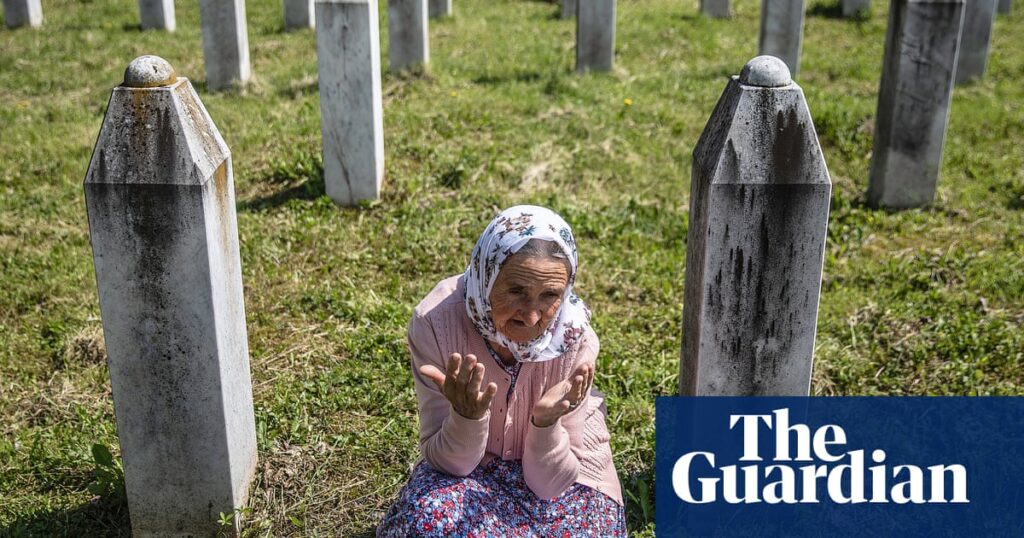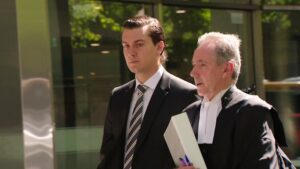
Three decades after the genocide in Srebrenica, memories of the atrocity are fading globally, aided by the relentless efforts of perpetrators and their allies to obscure the truth. Yet, the haunting landscape around Srebrenica continues to reveal its grim secrets, as bones resurface from the earth.
In Bratunac, a town just six miles north of Srebrenica, a poignant group burial took place recently. The remains of victims identified over the past year were laid to rest. Imams from across Bosnia gathered to offer prayers over six coffins draped in the blue and gold Bosnian flag. A crowd of around a thousand Bosniaks stood solemnly in the graveyard, where a backhoe had prepared six new graves, including a small trench for a one-year-old, Almera Paraganlija, killed alongside her mother by Bosnian Serb gunmen during the 1992 rampage through Joševa.
Hajrudin Paraganlija, husband and father to the deceased, witnessed their burial more than 30 years after their deaths. “It is a kind of peace to at least know where they are,” he expressed, although his grief-stricken demeanor told a different story. His mother and brother remain missing. As the mourners departed, local Serbs went about their day, avoiding eye contact, as if the mourners had become invisible.
The Legacy of Genocide and Denial
Bratunac and Srebrenica now lie within Republika Srpska, a Bosnian Serb entity established by the Dayton Peace Agreement in 1995. The local leadership not only denies the genocide but glorifies the perpetrators. Hariz Halilovich, a Srebrenica-born author and professor, highlights how denial has evolved into a mainstream celebration of genocide. His study on popular Serb songs reveals disturbing lyrics celebrating the massacre.
“The complete silence that came after the war has evolved into literally celebrating genocide,” said Hariz Halilovich.
Such denial is perpetuated by leaders like Milorad Dodik, who dismisses the genocide as an “arranged tragedy.” At the recent funerals, survivor Almasa Salihović emphasized the danger of denial as a potential second genocide, urging the community not to remain silent.
Historical Context and the Fight for Justice
The genocide in Srebrenica occurred in two brutal waves. The first in 1992, as part of Slobodan Milošević’s campaign for a Greater Serbia, saw coordinated attacks on Muslim villages. Survivors fled to Srebrenica, declared a UN “safe area” in 1993. However, in July 1995, the illusion of safety shattered when Bosnian Serb forces, led by Gen Ratko Mladić, attacked. The Dutch UN battalion failed to protect the civilians, leading to the massacre of over 8,000 men and boys.
The Srebrenica Memorial Centre, now a testament to the horrors endured, stands amidst ongoing denial. It was temporarily closed in March following threats from Dodik, but reopened to continue its mission of remembrance. Yet, in the surrounding areas, evidence of the genocide is being systematically erased.
Preserving Memory Amidst Hostility
Efforts to preserve the memory of the genocide face significant challenges. The Srebrenica Memorial Centre curates personal effects of the victims, each telling a silent story of life and loss. Emir Suljagić, the centre’s manager, underscores the importance of these artefacts in keeping the memory alive.
“These artefacts, in some cases, are probably the only physical proof of someone’s existence,” Suljagić said. “They speak for life, they speak for death, they speak for everything in between.”
Despite attempts to erase history, the centre continues to expand its exhibits, focusing on personal stories and the significance of recovered items. The struggle for memory is relentless, as survivors and their families fight against the tide of denial to ensure the voices of the dead are never silenced.
The ongoing battle for recognition and justice in Srebrenica serves as a stark reminder of the importance of confronting historical truths, not only for the victims and their families but for future generations. As the world reflects on the atrocities of the past, the fight for memory in Srebrenica remains a crucial endeavor in the pursuit of justice and reconciliation.







